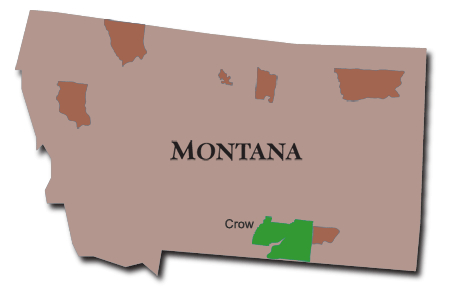| Home | About Us | Services | Success Stories | How to Help | Resources |
 |
of Plains Indians History and Culture Reservations South Dakota North Dakota Montana Blackfeet Crow Flathead Fort Belknap Fort Peck Northern Cheyenne Rocky Boy Wyoming Nebraska Idaho Living Conditions Site Map FAQs Gift Catalog IRS Form 990 |
Reservations Montana: Crow Reservation About the Crow: The Hidatsa-Crow originally lived in the Ohio country, migrating through northern Illinois, western Minnesota, and into the Red River Valley. They remained in this region for several hundred years, hunting buffalo and cultivating crops. The mid-sixteenth century witnessed another migration of the Hidatsa-Crow towards the upper Missouri River. By the late 17th century, the Crow moved to southwestern Montana and northern Wyoming. During the 18th century, the Crow acquired horses from the Shoshone, allowing them to become fully nomadic. As nomadic Plains Indians, the Crow tribe grew wealthy and strong though warring and horse raiding. They assisted the United States military as scouts against the Tribe’s traditional enemies, the Lakota and Nez Perce Indians. History of the Reservation: The 1851 Laramie Treaty granted the Crow 3.5 million acres, mostly in the Yellowstone region. However, despite helping the U.S. government in the Indian Wars of the 1870s, the Crow did not get better treatment than any other Indian tribe. By the 1880s, the Crow were forced by the government to cede a majority of their land. Allotments for private land were issued in 1887. Between 1922 and 1962 allotment holders sold much of their, mostly along the three rivers that ran through the Reservation, as a source for badly needed income. In the 1950s the government forced the Crow to sell their right to the Bighorn Canyon to make room for the Yellowtail dam, further gutting the Crow’s territory. Finally, in 1981, the state of Montana acquired ownership of the Bighorn River, whittling the Reservation down to 2.2 million acres. Life on the Reservation: A few service businesses exist in the small communities of Lodge Grass, Crow Agency, and Pryor. The tribal government, Little Bighorn College, and the federal government provide some jobs. Further meager income for the Tribe comes primarily from coal, oil and gas leases, and agricultural leases. These sources of employment remain largely inadequate: the jobless rate on the Crow Reservation runs at 44% and per capita income was $4,243 in 1989. How can I help? Crow on the map: Big Horn and Yellowstone counties, Montana. Tribal enrollment: 8,175 enrolled (4,724 resident) in 1990. |
Join our Circle of Friends - make a monthly gift!
We call this group Circle of Friends, because a friend is someone who makes a lasting commitment. You will receive* a free "thank you" gift for donating monthly: a beautiful dreamcatcher. (* While supplies last.) |






